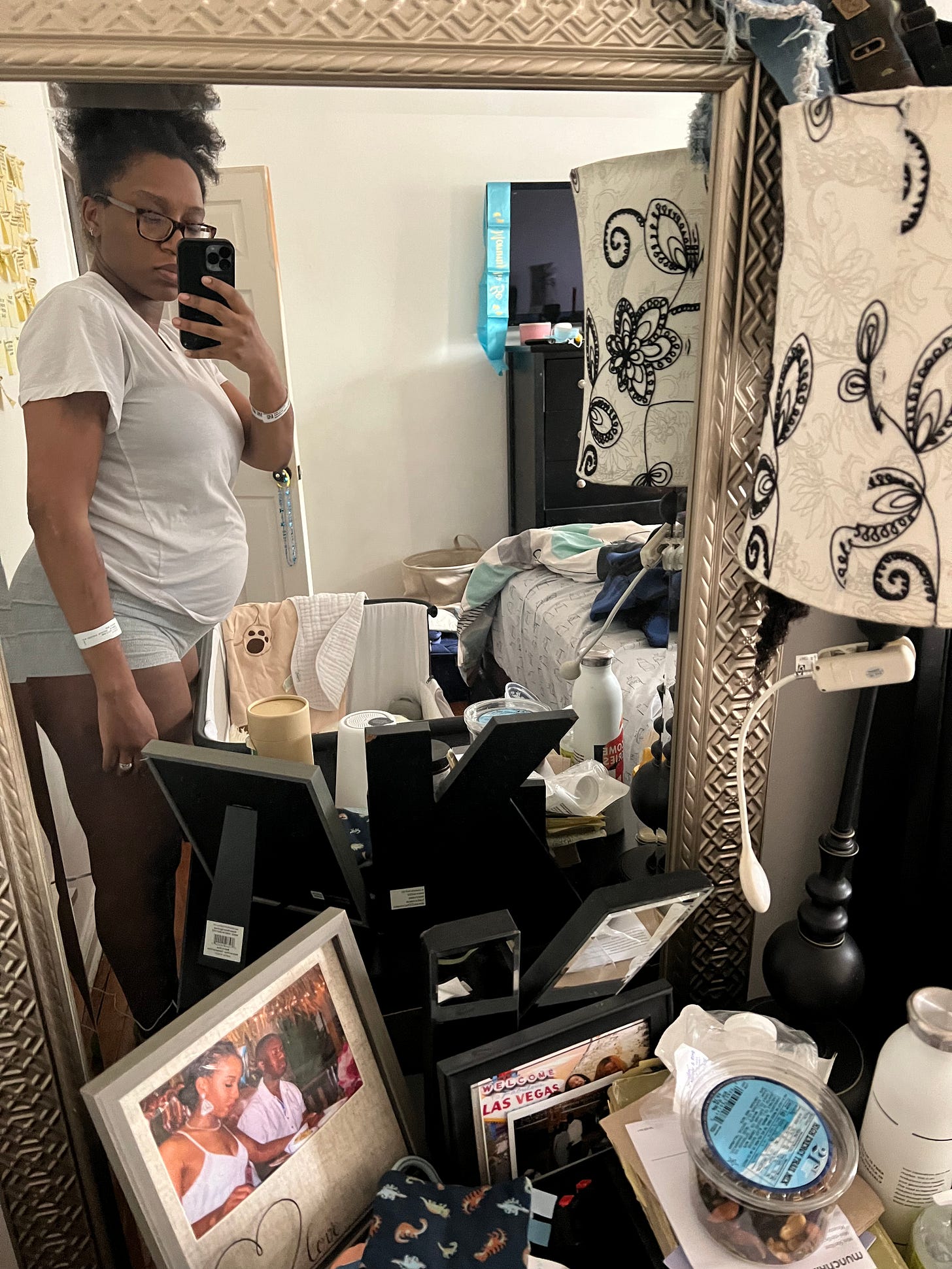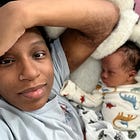Postpartum Recovery Checklist: How to Heal Faster After Birth
The postpartum period is tough! Here’s a checklist of must-have recovery tips and self-care essentials for new moms.
If you’re a new mom (or about to be one), congratulations! You’ve just accomplished something incredible. But while so much focus is placed on pregnancy and childbirth, postpartum recovery often gets overlooked.
Many new moms are caught off guard by the physical and emotional toll of recovery. Between sleepless nights, healing bodies, and learning to care for a newborn, it’s easy to feel overwhelmed. That’s why I’ve put together this Postpartum Recovery Checklist—so you can heal faster, feel better, and focus on bonding with your baby.
This picture perfectly captures my postpartum journey in those first few weeks- sleeping baby, disposable underwear, snacks and water within arm’s reach on my nightstand (C-section belly band not pictured).
Let’s dive in!
1. Healing After Vaginal Birth vs. C-Section
Your recovery will depend on how you gave birth. Here’s what to expect:
Vaginal Birth Recovery
✅ Perineal Care – Use a peri bottle with warm water when urinating and gently pat dry. Sitz baths can help with discomfort.
✅ Pain Relief – Witch hazel pads, ice packs, and numbing sprays can reduce soreness.
✅ Managing Stitches – If you had a tear or episiotomy, keep the area clean and dry.
✅ Pelvic Floor Health – Kegels help strengthen muscles and prevent incontinence.
C-Section Recovery
✅ Incision Care – Keep the incision clean and dry. Watch for signs of infection (redness, warmth, swelling).
✅ Pain Management – Take prescribed pain meds as needed, but stay ahead of the pain by taking them on schedule.
✅ Movement Matters – Walking helps circulation and prevents complications, but avoid heavy lifting.
✅ Core Support – A postpartum belly binder can provide extra support for your healing abdominal muscles.
2. Managing Pain, Bleeding, & Breastfeeding Challenges
Pain & Bleeding:
• Postpartum cramping is normal as your uterus shrinks back to size. A heating pad can help.
• Expect lochia (post-birth bleeding) for up to six weeks. Use heavy-duty pads, not tampons.
• Stay hydrated and eat fiber-rich foods to prevent constipation, which can make recovery harder.
Breastfeeding Challenges:
• Engorgement? Try warm compresses before nursing and cold packs afterward.
• Cracked nipples? Apply lanolin or breast milk to soothe irritation.
• Low supply worries? Nurse on demand, stay hydrated, and consider lactation support.
💡Pro tip: I noticed a significant boost in my milk supply when I started eating dates! While not widely studied, dates are believed to have galactagogue properties, meaning they may naturally promote lactation.
If you experience severe pain while breastfeeding, seek help from a lactation consultant.
3. Postpartum Preeclampsia: A Silent but Serious Condition
Many new moms assume preeclampsia (dangerously high blood pressure) only happens during pregnancy, but it can also develop after birth, even if you had normal blood pressure before. Postpartum preeclampsia typically occurs within the first 6 weeks after delivery and can lead to serious complications if untreated.
Signs & Symptoms to Watch For:
⚠️ High blood pressure (140/90 or higher)
⚠️ Severe headaches that don’t go away
⚠️ Vision changes (blurry vision, seeing spots)
⚠️ Swelling in the hands, face, or legs that worsens suddenly
⚠️ Shortness of breath
⚠️ Upper right abdominal pain
⚠️ Nausea or vomiting
🚨 Seek immediate medical attention if you experience these symptoms! Left untreated, postpartum preeclampsia can lead to seizures (eclampsia), stroke, or organ damage.
Who’s at Risk?
Women with a history of preeclampsia, high blood pressure, obesity, or certain medical conditions (such as diabetes) are at higher risk. However, postpartum preeclampsia can happen to anyone—even those with no prior risk factors.
If you’re diagnosed with postpartum preeclampsia, treatment typically includes blood pressure medications and close monitoring to prevent complications. Know the signs and advocate for your health!
4. Emotional Well-being: Baby Blues vs. Postpartum Depression
The emotional side of postpartum recovery is just as important as the physical. Here’s what’s normal—and what’s not.
✅ Baby Blues (lasts up to 2 weeks): Mood swings, crying, anxiety, and feeling overwhelmed. This is common due to hormonal shifts.
🚨 Postpartum Depression (can last months): Persistent sadness, lack of interest in your baby, extreme fatigue, or intrusive thoughts. This is a serious condition that requires professional support.
If you feel like something isn’t right emotionally, reach out for help. There is no shame in needing support!
5. When to Call Your Doctor for Recovery Concerns
Postpartum recovery is different for everyone, but seek medical attention if you experience:
⚠️ Heavy bleeding (soaking more than one pad per hour)
⚠️ Large blood clots (bigger than a golf ball)
⚠️ Signs of infection (fever, foul-smelling discharge, or incision redness)
⚠️ Severe pain that isn’t relieved with medication
⚠️ Intense sadness or thoughts of harming yourself or your baby
Your health matters just as much as your baby’s! Don’t hesitate to call your doctor if something feels off.
You’ve Got This, Mama!
Postpartum recovery isn’t easy, but with the right care and support, you’ll heal and regain your strength. Give yourself grace, accept help, and prioritize rest whenever possible.
What helped YOU the most during postpartum recovery? Share your thoughts in the comments!
✨ Get Even More Expert Support with a Paid Subscription! ✨
Want exclusive access to video demonstrations backed by expert tips? I’m here to help you navigate common newborn challenges with confidence. With a paid subscription, you’ll get:
✔️ Expert-Led Parenting Support – No more second-guessing! Get clear, evidence-based advice on sleep, feeding, milestones, and common baby health concerns—all from a trusted medical professional.
✔️ Exclusive Q&A Access – Have a burning question about your baby? Paid members get priority access to ask me directly in our members-only Q&A sessions.
✔️ Easy-to-Digest Guides – From newborn sleep routines to introducing solids, I break down the essentials into practical, actionable steps so you can parent with confidence.
✔️ A Supportive Community – Join a private space where parents can connect, share experiences, and support each other—because no one should have to navigate this alone.
These expert-backed techniques can make a big difference in your baby’s comfort and well-being—and I’ll walk you through them step by step!
Upgrade to paid subscription now for exclusive content designed to support you every step of the way!
Next up in my free newsletter: Newborn Essentials Checklist: Must-Have Baby Items (Free Printable!)
Follow @CubConvos on Instagram and TikTok for more newborn tips and expert advice!
Enjoyed this newsletter? Share it with a fellow parent! Thanks again for being here- I can’t wait to support you on this journey!
Kelly-Ann Smith,
Pediatric Nurse Practitioner | Founder of Cub Convos @cubconvos








This is a great list and you’re absolutely right the postpartum recovery is often overlooked!
I found the little things made a big difference in my wellbeing, for example a comfy fluffy pair of socks (this was November!), super baggy clothes which is a given probably - but when I had my c-section every pair of pyjamas sat on the scar line and I had to get my husband to do a mad dash to a shop to buy me bigger baggy tops! I also didn’t anticipate how bad my feet would swell up, I couldn’t fit in any of my shoes or slippers after so again he had to buy something!